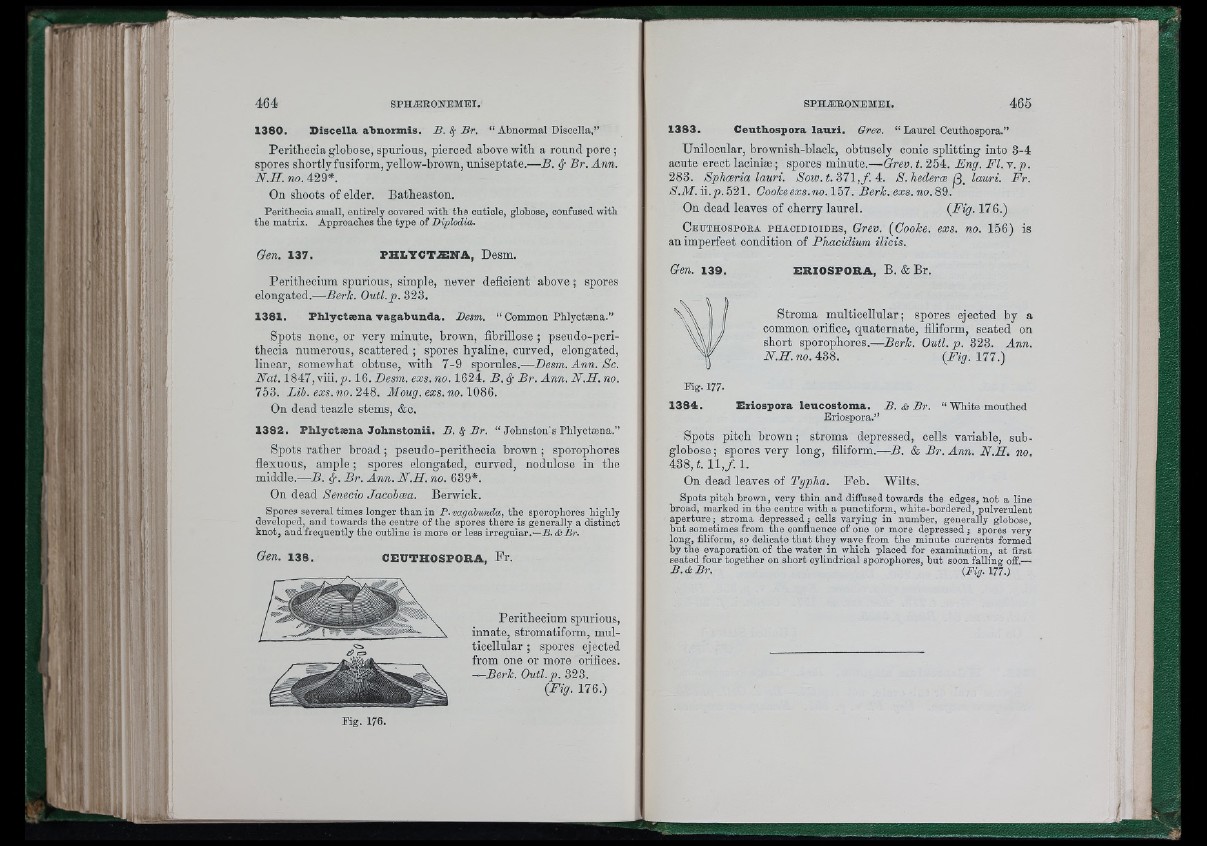
I
■ 1
t
I' 1
i!1
i , :
I ■ '■
1 3 8 0 . D is c e lla a b n o im is . B . 4 Br. “ Abnomial Disoella.”
Perithecia globose, spurious, pierced above with a round pore ;
spores shortly fusiform, yellow-brown, uniseptate.—B. / Br. Ann.
N .II. no. 429*.
On sboots of elder. Batheaston.
Peritheoia small, entirely covered with tha cuticle, globose, confused with
the matrix. Approaches the type of Diplodia.
Gen. 1 3 7 . PH LY C TÆ N A , Desm.
Peritbecium spurious, simple, never deficient above; spores
elongated.—Berlc. Outl.p. 3 23.
1 3 8 1 . Phly cta ena v a g ab u n d a . Desm. “ Common Phlyctaana.”
Spots none, or very minute, brown, fibrillose ; pseudo-peri-
thecia nnmerous, scattered ; spores byaline, curved, elongated,
linear, somewhat obtuse, witb 7 -9 sporules.—Desm. Ann. Sc.
Nat. 1847, viii.)». 16. Desm. exs. no. 1 6 2 4 . B. / Br. Ann. N .H . no.
753. Lih. exs. no. 248. Moug. exs. no. 1686.
On dead teazle stems, &c.
1 3 8 2 . P h ly c tsen a J o h n s to n ii. B . 4 B r . “ Johnston’s Phlyottena.”
Spots rather bro ad ; pseudo-peritbecia brown ; sporophores
flexuous, am ple; spores elongated, curved, nodulose in tbe
middle.—B. / . Br. Ann. N .H . no. 639*.
On dead Senecio Jacohwa. Berwick.
Spores several times longer than in P. vagalunda, the sporophores highly
developed, and towards the centre of the spores there is generally a distinct
knot, and frequently the outline is more or less irregular.—R. ABr.
Gen. 1 3 8 . CEUTHOSPOB.A, Fr.
Perithecium spurious,
innate, stromatiform, multicellular
; spores ejected
from one or more orifices.
— Berh. Outl.p. 323.
{Fig. 176.)
1 3 8 3 . Ceuthospoza la u i i . Orev. “ Laurel Ceuthospora.”
Unilocular, brownisb-black, obtusely conic splitting into 3 -4
acute erect laciniæ ; spores minute.— Grev. t. 254. Eng. F l. r .p .
2 8 3 . Sphceria lauri. Sow. t. 811, f . 4. S. hederce lauri. Fr.
S.M. ii.p .521. Oooheexs.no.l51. Berh. exs. no.89.
On dead leaves o f cberry laurel. {Fig. 1 7 6 .)
Ceuthospoka phaoidioides, Grev. [Ooohe. exs. no. 1 5 6 ) is
an imperfect condition o f Phacidium ilicis.
Gen. 1 3 9 . ERIOSFORA, B. & Br.
Stroma multicellular; spores ejected by a
common orifice, quaternate, filiform, seated on
short sporophores.—Berh. Outl.p. 323. Ann.
N .H . no. 4 3 8 . {Fig. 111.)
Fig. 177.
1 3 8 4 . Eziospoza leu c o s tom a . B .A B r . “ 'White mouthed
Briospora.”
Spots pitch brown; stroma depressed, cells variable, subglobose
; spores very long, filiform.—B. & Br. Ann. N .H . no.
4 3 8 , i. 1 1 , / . 1.
On dead leaves of Typha. Feb. Wilts.
Spots pitch brown, very thin and diffused towards the edges, not a line
broad, marked in the centre with a punctiform, white-bordered, pulverulent
aperture; stroma depressed ; cells varying in number, generally globose,
but sometimes from the conflueuce of one or more depressed ; spores very
long, filiform, so delicate that they wave from the minute currents formed
by the evaporation of the water in which placed for examination, at first
seated four together on short cylindrical sporophores, but soon falling off.—
B .A B r . {F ig .m .)